Abstract: Electronic waste (e-waste) is a rising issue in Vietnam, due to a dramatic increase in the waste volume, and the lack of recovering materials. This research provides an overview of e-waste in Vietnam, which is currently considered to be hazardous waste. This paper also discusses the recycling technologies and perspective of e-waste recycling in the near future. It has been shown that Vietnam can only recover some common materials (such as
iron, copper, aluminum, etc.) from e-waste with low efficiency. The recovering process can cause serious impacts on the environment and public health. In addition, the parts of e-waste that are not recycled in Vietnam have been illegally exported to other countries. It violates the BASEL Convention and causes a loss of an important ‘‘urban resource’’. Recycling e-waste had not been regulated by Vietnamese government for a long time. As a result, this type of waste got under the control of informal sector. To respond to this situation, the Extended Producer Responsibility system will be applied in Vietnam in 2016. Due to the introduction of the new legislation, there would be an important reform in the recycling sector that is expected to increase the efficiency of the recycling system.
Introduction
The electronic waste (e-waste) is an emerging issue in Vietnam within the past 10 years, due to the impact of discarding and recycling thiswaste on the environment and public health. Also, there is a warning alert of an international e-waste flow running to or through Vietnam, disregarding the Vietnam’s ratification of the BASEL Convention introduced in 1995.
The amount of valuable materials from e-waste is large enough to drawattention ofmaterial recycling field.However, there has not been any complete e-waste recycling technology applied in Vietnam. Most e-waste is handled by informal private sector, using a simple andmanual dismantling process, which can recover only a small amount of some basic metals or plastic. The remaining parts are either disposed or exported. This informal recycling causes serious impacts on environment, and results in wasting of a considerable amount of secondary materials, including precious and rare metals.
The rising concerns on the e-waste forces Vietnam to face the fact that most hazardous matters remain in Vietnam while most valuable materials leave the country as noted in the research by Shinkuma and Huong [1] and Kojima [2]. The e-waste management in Vietnam is not sustainable. Therefore, the country should soon consider whether to keep the present situation or prepare a new and proper management system that can meet the global or regional standards, and the demand of secondary material market.
E-waste generation
Increasing trend in home electronic appliances
A sharp increase in electronic demand along with the development of socio-economy led to a booming electronic market. According to Vietnam General Statistic Office (GSO), the rate of households that have color television (TV) has increased from 0.698 unit/household in the year 2004 to 0.859 unit/household in 2010 [3]. These numbers are 0.166 and 0.397 for refrigerator, 0.022 and 0.094 for air conditioner, 0.051 and 0.170 for computer, 0.062 and 0.176 for washing machine, respectively. The percentage of households who purchased durable goods increased from 32.8 % (in 2002) to 48.4 % (in 2010).
In one research, The Hanoi Urban Environment Company (URENCO) estimated a supply demand in the country up to 2020 as follows: about 44.4 million sets of TVs, 9.9 million refrigerators, 8.3 million washing machines, and 4.3 million air conditioners [4]. However, estimated shipment, according to Quang et al. [5], in 2020 will be around 9.1 million set of TVs, 4.9 million refrigerators, 3.8 million washing machines and 831 thousand air conditioners, which would be much smaller compared to the demand.
Therefore, besides the brand new appliance market, there is a second-hand market that brings the ‘‘end-of-life’’ appliances back to users after being repaired or refurbished. Though the amount of domestic production has been increasing dramatically since 2000, and the imported value of electronic appliances continuously arises, second-hand appliances still counts for 20 % total market value as pointed out by Quang et al. [6]. This second-hand market helps low-income people to acquire appliances at an affordable price. It also extends the life span of the appliances, and thus, can reduce the e-waste generation. It could benefit Vietnam because the country has no proper treatment/ recycling system for e-waste. However, it also creates a ‘‘shadow market’’ because it is challenging to evaluate the quality of appliances for their sale price and being taxed. In addition, the second-hand market promotes the involvement of the informal sectors, such as dismantler and junk shops, in the e-waste flow. As a result, it is difficult for the government to put e-waste under a full control.
Increasing trend in generation of e-wastes
In Vietnam, e-waste is mainly generated from household (electronic home appliances), offices (business machines such as personal computers, photocopiers, fax machines, printers and scanners), and from electronic industrial (mostly composed of failed electronic parts/devices/products). E-waste also comes from discarded appliances imported illegal from overseas, and from dismantling and recycling sites. Among these e-waste sources, the end-oflife appliances from households draw great attention due to its large volume and the unsafe management.
So far, there is no official inventory data referring to the amount of e-waste that is generated in Vietnam. In a very first research on the large home appliance inventory, Hai et al. estimated that in the period 2000–2006, the number of discarded TV was about 446 thousand units, 101 thousand refrigerators, 37 thousand washing machines, and 11.6 thousand air conditioner [7]. URENCO, in their research work, estimated that the number of discarded home electronic appliance in Vietnam is about 1.8 million pieces (including 742.5 thousand TVs, 398 thousand refrigerators, 107.5 thousand air conditioners and 543 thousand washing machines) in 2010 [4], as shown in Table 1. The estimation is based on the increase of GDP. The discarded rate is estimated using Weibull function for the lifespan of appliance. Quang et al. used a combination model that included the logistic function, population balance and Weibull distribution to calculate. The estimated number was 3.8 mil. pieces (including 2.7 mil. TVs, 652 thousand refrigerators, 389 thousand washing machines and 62 thousand air conditioners) in the same year, as seen in Fig. 1 [5]. In 2020, both researches showed similar estimated numbers. URENCO estimated about 10.6 million pieces (including 4.85 mil. TVs, 2.27 million refrigerators, 2.6 million washing machines and 873 thousand air conditioners), while Quang et al. estimated the number at 12.1 million pieces (including 6.5 mil. TVs, 3.4 million refrigerators, 1.9 million washing machines and 284 thousand air conditioners). It should be noted that there is no published data on mobile phones, one of the most popular appliances that has largest number of discarding (due to its short lifespan), despite of its valuable content. This kind of e-waste is collected by the private collection system, and thus, no information about the volume and the destination of this flow is available, even estimated data.
When tracking the flow of e-waste containers from North America, BASEL Action Network pointed out that Vietnam was ranked number three in the Asia (just behind China and Hong Kong) in importing e-waste. [8]. This fact shows the existence of an illegal and unclear flow of e-waste, and second-hand appliances into Vietnam [1]. It is suspected that Vietnam might be the stop-over port in this flow channel, before the e-waste ends at China or Hong Kong (temporary import for re-export e-waste). Even if it is true, it might cause many problems to the environment and public health when the wastes are cleaned and re-packed in Vietnam before being re-exported.
Management of e-waste in Vietnam
Commonly, the flow of end-of-life appliances in Vietnam involves with six main stakeholders that can be defined as: (1) consumer; (2) private collector; (3) junk shop; (4) dismantler, (5) recycler or treatment unit; and (6) exporter as pointed in Fig. 2.
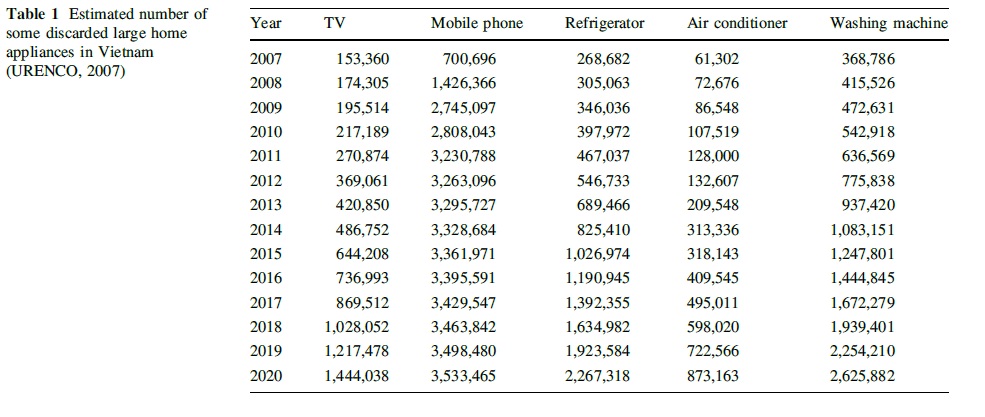
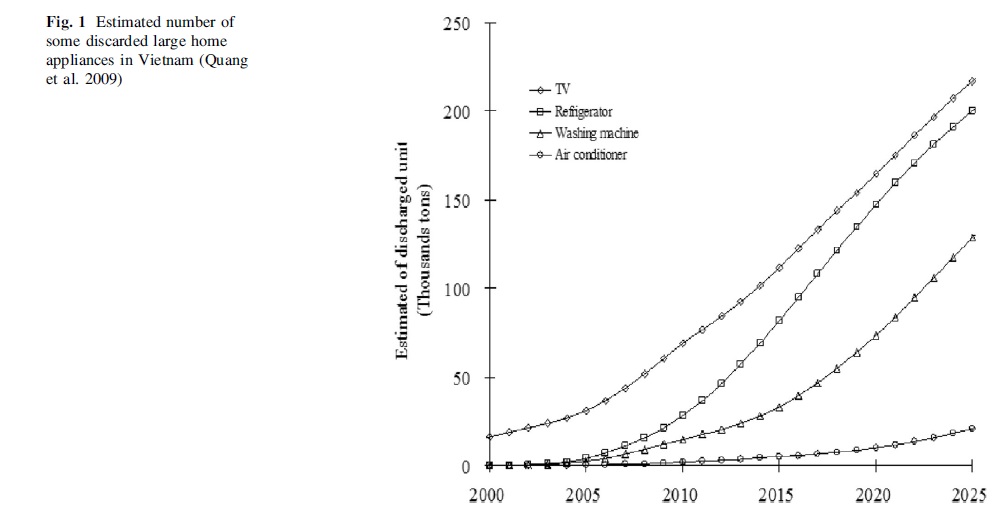
To date, the popular way to discard home appliance is mostly selling to the private collector, giving to other, or keeping at home [5]. The private collector buys the appliance, screens it for quality before bring to dismantler for dismantling, or junk shop for reuse/refurbishing. In fact, due to the benefit from e-waste, the private collection system in Vietnam is quite flexible, active and successful on collecting the e-waste in general [5]. The junk shop can provide not only the repair work, but also the refurbishing/remanufacturing appliance. It can also play a role of dismantler for the appliance that cannot be reused. The appliance can then be dismantled by the dismantler or junk shop into different groups of materials and parts/devices. From the dismantler, the recyclable materials, including iron, aluminum, copper, lead and plastic, are sold to the recycler for their recycling. Those parts are un-recyclable, such as Cathode Ray Tube (CRT), Brominated Flame Retardant (BFRs) plastic, Printed Circuit Board (PCB) and some types of circuit element are exported.
Most of the e-waste flow in Vietnam is handled by the informal sector, that focuses on dismantling or refurbishing discarded appliances rather than recycling them (as shown in Fig. 3). It is noticed in the research work of Hai and Quang [9] that the most popular method is the dismantling, in which e-waste is classified into different parts and materials. Due to the manual and unsafely process, it leads to many problems in environment and public health, as shown in researches in the e-waste dismantling sites by Tue and colleagues [10–12].
It is shown that the current informal system in Vietnam can only recycle some of the bulk materials such as ferrous, copper, aluminum and a few types of plastic, due to the small amount of e-waste flow and lack of technology. Additionally, the market that consumes recycled materials is not developed enough to promote a formal recycling process.
On one hand, it is a challenge for Vietnam to put the e-waste under the government control and the Extended Producer Responsibility (EPR) policy like it is done in many other countries. On the other hand, it will open an opportunity for the formal recycling sector to access not only those common recycling materials, but also precious and rare metals, which are virtually ignored by the current recovery sector.
Legislation
Generally, the recycling of waste is encouraged by many waste-relating legislation, such as the Amendment Law on Environmental Protection 2004 (then replaced by the Law on Environmental Protection No. 55/2014/QH13 in 2015), the National Strategy for integrated management of solid waste until 2025, with a vision to 2050 (issued by the Decision 2149/QD-TTg, dated 17, Dec, 2009) and the Decree 38/2015/ND-CP on Management of Waste and Discarded Materials. Nevertheless, as long as the discarded home appliance is considered to be hazardous waste (that is managed by the Circular 12/2011/TT-BTNMT on the stipulating hazardous waste management), the formal collection and treatment system encounter many difficulties in licence, transportation, storage, recycling and treatment technology, and equipment. This fact leads to the inefficiency of management system, and causes a loss of natural resources instead of making use of them.
In 2013, the Prime Minister’s Decision No. 50/2013/QDTTg (9 August 2013) on Prescribing Retrieval and Disposal of Discarded Products has been issued as the first legislation that considers e-waste a specific waste, which can be exempted from being registered hazardous waste treatment. It can be considered to be the first legal base for setting up the management system of the e-waste based on the full EPR policy, which stipulates all of the responsibility on retrieval and disposal of the discarded product to the producer/importer/ distributor. In 2014, The Law on Environmental Protection clearly pointed out that the producer/distributor has responsibility to collect and treat the discarded products (article 87), and the customers are responsible for taking discarded products to proper places (Article 88). These terms are iterated in detail by the Decision 16/QD-TTg (22 May 2015), which is replaced the Decision 50/QD-TTg. It is important to note that, according to the Article 1, the e-waste is not considered to be managed by the Decree 38/2015/NDCP on Management of Waste and Discarded Materials.
It is expected that with the issuing of these decisions, the discarding habits of public would change and thus, place the whole management system under the control of the government. These legislations are expected to be the legal basis for appropriate management of e-waste in Vietnam.
e-Waste recycling technologies in Vietnam
Within the past few years, some medium and large enterprises have invested in the hazardous waste treatment technology (including e-waste), forming up an initiative for formal recycling system in Vietnam. At the present, there have been 15 companies that have license to treat e-waste with capacities ranging from 0.25 to 30 ton/day over the country. Among them, only 3 companies can be considered that they have e-waste treatment. They include (1) The Commercial and Service Green Environment Co. Ltd (Hai Duong Province), (2) Viet Xanh Environmental Co. Ltd. (Binh Du’o’ng Province), and, (3) Hoa Binh Treatment and Recycling of Industrial Waste Joint-stock Company. However, most of the treatment lines are operated for industrial e-waste only, not home equipments. Besides, they can treat only a very small amount of e-waste generated. The main reason is that the treatment of the industrial electronic waste gains much higher benefit than the treatment of the end-of-life appliances, due to (a) the higher contents of valuable material in industrial e-waste, and (b) industrial e-waste is in hazardous waste category.
The pre-treatment is normally a process that disassembles the appliances into recyclable and unrecyclable parts (dismantling). The unrecyclable parts are crushed into small pieces. Materials are separated mostly by gravitational method. In this stage, hazardous liquids such as coolant (from refrigerator and air conditioner) or lubricant (from washing machine and air conditioner) are removed without treatment. This process is mostly employed in licensed e-waste treatment companies because of the high benefit. In the separation stage, shredding or crushing is normally used to reduce the volume of waste prior to hydro-metallurgy (in case of Green Environment Co. Ltd, Viet Xanh Environmental Co. Ltd and Hoa Binh Company) or storage (in case of CRT glass, as in URENCO Hanoi). In this stage, e-waste is grinded into small pieces and separated under gravity. Heavily metallic materials and light plastic are separated in the next step. In this stage, the recyclable parts, mostly metals, are enriched.
Most formal treatment and recycling line consists of three major stages using manual or semi-mechanized sections as shown in the Fig. 4.
The hydro-metallurgy is the main technique to treat e-waste in Vietnam. In this step, e-waste is dissolved acids or organic solvent to convert metals into solution. The metals then are recovery by physio-chemical or electrolysis process. This treatment process is applied in three listed companies above. Different products are formed depending on the metal recovery phase. For example, in Green Environment Co. Ltd, the main product from hydro-metallurgy treatment is copper sulfate, while in Hoa Binh Company, the product is crude copper ingot from electrolysis. However, in general, this stage is rarely operated due to: (1) the low economic benefit, because the operator needs to pay for the e-waste except the industrial e-waste; (2) the generation of waste water that contained heavy metals (hazardous waste); and (3) the low efficiency of removal and recovery metals from e-waste. Therefore, the hydro-metallurgy is usually employed for treatment of the industrial electronic waste, since the operator is paid for the treatment of this type of waste.
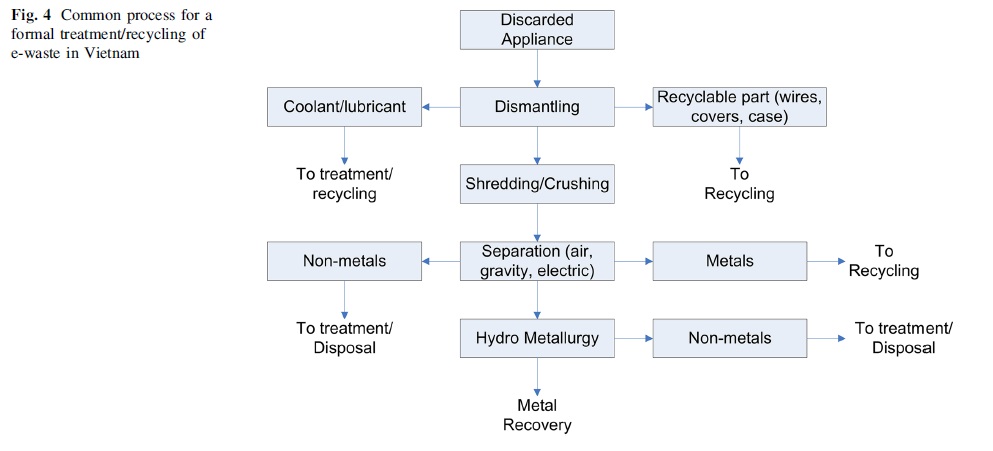
For industrial electronic waste, that mostly composed of PCB waste, the common treatment processes are combustion and hydro-metallurgy in order to recycle some of metallic byproducts. Operators who treat industrial e-waste get payment from the generator for the e-waste treatment, and benefit of selling recycling products. The total benefit is different compared to that of treatment of household appliances.
In the formal enterprises, such as Tan Thuan Phong Company and URENCO Hanoi, thermal process is used to treat the disposed industrial waste of PCB. The major equipment used in the thermal treating process is the incinerator, which is specifically designed for two grades of burning process. The burning process is automatically controlled. The waste feeding process can be done either manually or automatically. The emission is either treated or, recovered for heat. The slag from the incinerator can be recycled again, or brought to specific treatment, such as using in the cement or brick production. Nevertheless, the amount of e-waste that is treated by the thermal process in the formal enterprise is very small compared to the generated amount and the total weight of e-waste.
The hydro-metallurgy applied to recover copper and manganese from PCB waste is shown in Fig. 5. The PCB waste is separated from electronic element/device, and crushed into small pieces. Then, it is soaked in H2SO4 solution for the removal of copper and manganese as in a form of sulfate salts. Up to 95 % copper and manganese sulfates are crystallized and separated from the solution. This solid residues are collected and combusted. The liquid residue then is sent back to the batch.
Recycling technology perspective
Realizing the advantage of e-waste recycling compared to the e-waste treatment, some initial researches have been conducted at School of Environmental Science and Technology, (Hanoi University of Science and Technology), and University of Natural Science (Hanoi National University), which are considered to be the leading research institutes in the field of recycling e-waste in Vietnam.
Previous researches in Vietnam can be summarized in Fig. 6. It shows the effort to recover valuable materials from e-waste. Most of the researches focuses on the recovery of copper in PCB waste, for example the joint researches between INEST and KIGAM (Korea Institute of Geoscience and Mineral Resources) [13–18]. Currently, advanced researches focus on utilization of materials from e-waste, such as thermal retardant plastic from the cover or PCB, funnel/panel glass from CRT, and precious metals from media appliances (cameras, cell phone), though media appliances are not recycled in Vietnam at present. The flame retardant plastic is studied to replace inorganic additives used in production of thermo-resin or thermohardening resin. The panel glass is directly used as raw material for concrete brick production [19]. The result of preliminary research showed that the product satisfied the National Standard TCVN 9030:2011 on lightweight concrete testing. Other researches conducted by INEST on the efficiency of recovering precious metals (Au) using Thiosulfate [20–22] and bacteria [23] showed the new trend in e-waste recycling technology in Vietnam. Though being in research and development (R&D) phase, these researches can contribute to the establishment of proper management system of e-waste that can satisfy the utilization demand of e-waste instead of hazardous waste treatment. In the near future, the research should focus on increasing process efficiency and developing recycling process at industrial scale. Furthermore, the treatment of PCB using industrial pyrometallurgy process is also suggested as one of the proper ways to recover metals. However, Vietnam does not have sufficient technology for the e-waste recycling.
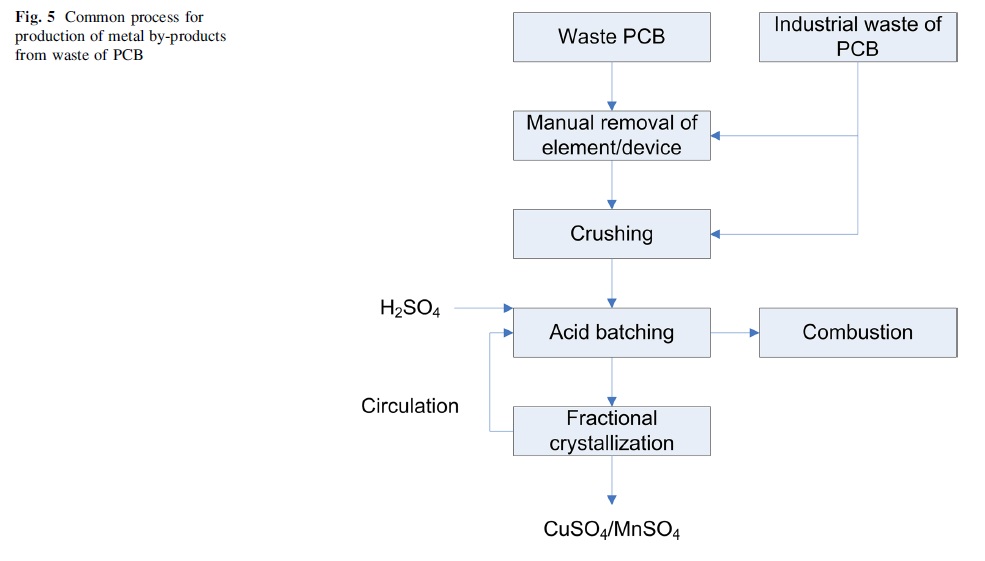
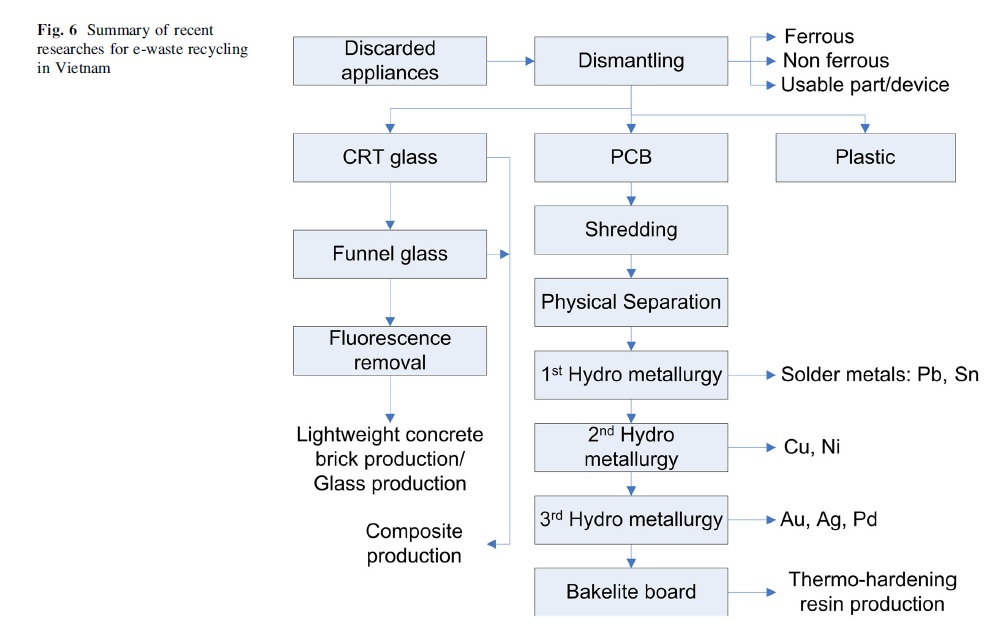
Nevertheless, these researches might not lead to the expected Best Available Technologies (BATs) that can be applied to the recycling of e-waste in Vietnam, until the EPR system is applied. Without this system, the BATs for e-waste recycling in Vietnam will remain as dismantling rather than recycling, due to the cost and efficiency of the e-waste collection. However, the EPR system is confronting with difficulties that cannot be overcome at the present, due to the infrastructure needed to manage getting electronic products for treatment, or recycling. If nothing is changed, Vietnam will have to consider a scenario, in which it is allowed to export e-waste to proper countries that can accept the waste flow under BASEL Convention.
Conclusion
At the present, e-waste issue draws a lot of attention from not only the authorities but also scientists and businesses, due to the increase in waste volume, and the potentials of recovering many types of materials. Nevertheless, Vietnam has not had any management system that can control a large amount of e-waste, and recover valuable materials. E-waste is mostly handled in the informal sector, and thus, cause negative impacts on environment and public health. In consequence of the introduction of the new legislation on the national e-waste management strategy, reforming the e-waste recycling sector becomes important. Recent advanced researches in Vietnam are focusing on using e-waste as secondary material resource. It is important to Vietnam to develop a proper and sustainable management system of e-waste.
Acknowledgments The authors acknowledge financial support from the Korea International Cooperation Agency under ODA Project Research Capacity Building, Waste Recycling Technology Development and Transfer in Vietnam.
References
1. Shinkuma T, Minh Huong NT. The flow of e-waste material in the Asian region and a reconsideration of international trade policies on e-waste. Environ Impact Assess Rev 29(1):25–31
2. (2011) Kojima, Michida (eds) Economic integration and recycling in Asia: an interim report, Chosakenkyu Hokokusho, Institute of Developing Economies
3. General Statistical Office. Result of the Vietnam Household Living Standard Survey 2010. Statistical Publishing House, Hanoi 2011 (obtained from http://www.gso.gov.vn/default_en. aspx?tabid=515&idmid=5&ItemID=12426)
4. Urban Environmental and Resource Cooperation (URENCO). Report on The Development of E-waste Inventory in Vietnam, 2007 (obtained from http://archive.basel.int/techmatters/e_wastes/E-waste%20Inventory%20in%20Vietnam.pdf)
5. Nguyen D-Q, Yamasue E, Okumura H, Ishihara Keiichi N (2009) Use and disposal of large home electronic appliances in Vietnam. J Mat Cycles Waste Manage 11(4):358–366
6. Nguyen D-Q, Pham X-T, Huynh T-H, Keiichi NI (2010) A new approaches for the evaluation of recycling system for electronic waste in Vietnam. Vietnamese J Sci Technol (Technical Universities, ISSN 0868-3980) 78A:102–108
7. Hai HT, Hung HV, Khoa DB, Mai CX (2006) Electronic waste inventory and its management in Vietnam. On the Proceeding of Third NIES Workshop on e-waste, Tsukuba, Japan pp 91–102
8. Puckett K (2010) Illegal global trafficking in e-waste: a call to action. Presented in the Interpol Global E-waste Crime Group Meeting
9. Hai HT, Quang ND (2010) E-waste: current status and perspectives in Vietnam. On the Proceeding of the 2nd Regional Conference on Global Environment, pp 180–189 (HCMC, 8–9th, Mar, 2010)
10. Tue NM, Sudaryanto A, Minh TB, Isobe T, Takahashi S, Viet PH, Tanabe S (2010) Accumulation of polychlorinated biphenyls and brominated flame retardants in breast milk from women living in Vietnamese e-waste recycling sites. Sci Total Environ 408(9):2155–2162
11. Nguyen MT, Shin T, Go S, Tomohiko I, Pham HV, Yuso K, Nobuyasu S, Gan Z, Agus S, Shinsuke T (2013) Contamination of indoor dust and air by polychlorinated biphenyls and brominated flame retardants and relevance of non-dietary exposure in Vietnamese informal e-waste recycling sites. Environ Int 51:160–167
12. Tanabe S, Suzuki G, Tue NM, Viet PH, Takahashi S, Isobe T, Trang PTK (2010) Evaluation of dioxin-like activities in settled house dust from Vietnamese e-waste recycling sites: relevance of polychlorinated/brominated dibenzo-p-dioxin/furans and dioxinlike PCBs. Environ Sci Technol 44(23):9195–9200
13. Le Long H, Jeong J, Lee J-C, Pandey BD, Yoo J-M, Hai HT (2011) Hydrometallurgical Process for Copper Recovery from Waste Printed Circuit Boards (PCBs). Miner Process Extr Metall Rev 32(2):90–104
14. Hoang LL, Huynh TH, Jinki J, Jae-Chun L (2010) Leaching of copper from waste printed circuit boards by HNO3 acid solution. Vietnamese J Chem (ISSN 0866-7144), 48(6):699–703 (in Vietnamese)
15. Ha VH, Cao XM, Huynh TH, Tran ÐC, Jae-chun L, Jinki J, Jamin Y (2010) Recovery of copper from printed circuit boards of waste electric and electronic equipments. Vietnamese J Chem (ISSN 0866-7144), 48(2):169–175 (in Vietnamese)
16. Ha VH, Huynh TH (2013) Dynamic of copper leaching from wasted printed circuit board using ammoniac solution. Vietnamese J Sci Technol 3B
17. Ha VH, Bui TTH, Nguyen TTH, Pham TKT, Huynh TH, Mai TT (2014) Recovery of copper from the ammonia leaching solution of printed circuit boards by electrowinning. Vietnamese J Sci Technol 52(3A):231–237
18. Ha VH, Huynh TH (2015) Improvement of Copper Electrowinning conditions from Leached Solution of Printed Circuit Boards. Vietnamese J Sci Technol 53(3B):109–114
19. Wiesmeth, Hans, Ha¨ck D, Do, Quang T, Bui DC (2012) A holistic approach to recycling of CRT glass and PCBs in Vietnam. J Vietnam Environ (ISSN: 2193-6471) 2(1):1–7
20. Vinh HH, Jae-chun L, Jinki J, Huynh TH, Manis KJ (2010) Thiosulfate leaching of gold from waste mobile phones. J Hazardous Mater 178(1–3):1115–1119
21. Ha VH, Huynh TH, Ngo TN, Jae-chun L, Jinki J (2011) Study on effect of temperature on gold leaching from electronic scraps using thiosulphate with copper (II) catalyst in ammonia media. Vietnamese J Sci Technol (Technical Universities, ISSN 0868-3980) 82A:37–41
22. Ha VH, Huynh TH, Jae-chun L, Jinki J, Pandey BD (2014) Optimizing the thiosulfate leaching of gold from printed circuit boards of discarded mobile phone. J Hydrometall 149:118–126
23. Chi DT, Jae-chun L, Pandey BD, Jinki J, Kyoungkeun Y (2011) Bacterial cyanide generation in presence of metal ions (Na?, Mg2?, Fe2?, Pb2?) and gold bioleaching from waste PCBs. J Chem Eng Japn 44(10):692–700
Huynh Trung Hai, Ha Vinh Hung, Nguyen Duc Quang
School of Environmental Science and Technology
University of Science and Technology
No. 1 Dai Co Viet Str., Hanoi


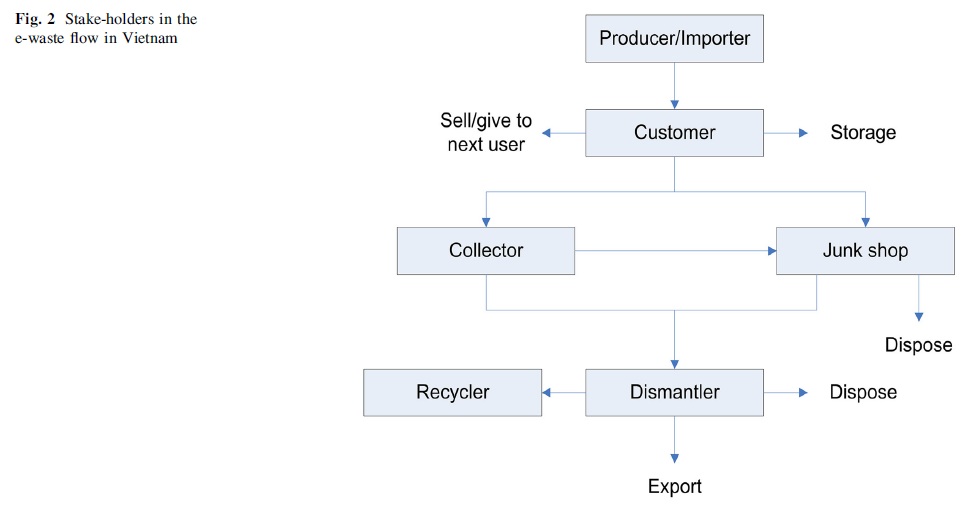
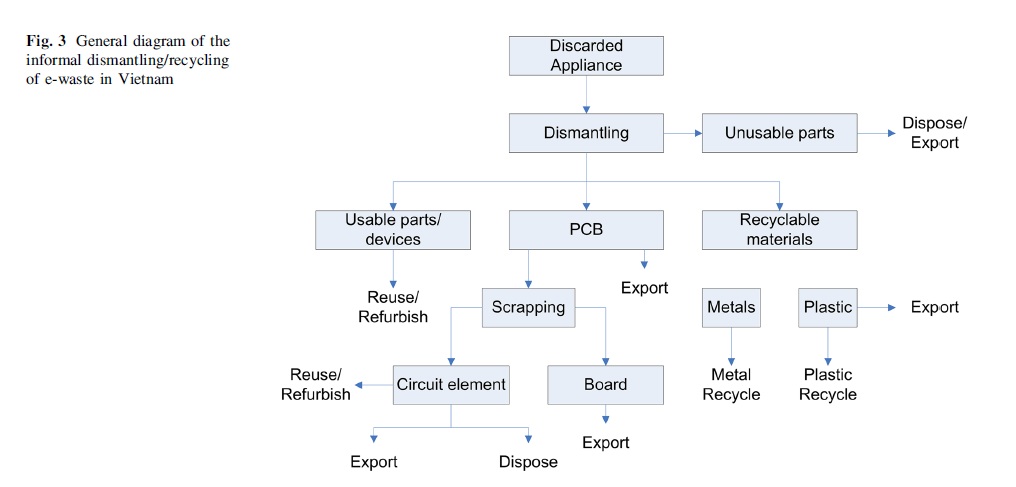



 Promoting the cold storage market to optimize the strengths of agricultural products
Promoting the cold storage market to optimize the strengths of agricultural products
.jpg?w=280&h=160&mode=crop) Greening the textile industry from the perspective of ESCO model
Greening the textile industry from the perspective of ESCO model
 VICEM strives towards sustainable development
VICEM strives towards sustainable development
 Develop new tool to reduce, reuse and recycle in industry
Develop new tool to reduce, reuse and recycle in industry
 Bac Kan promotes sustainable production and consumption
Bac Kan promotes sustainable production and consumption
 Germany's new plant produces zero-emission jet fuel
Germany's new plant produces zero-emission jet fuel
 Encouraging results from watershed pollution control
Encouraging results from watershed pollution control
.jpg?w=280&h=160&mode=crop) Promote energy labeling towards high efficiency products
Promote energy labeling towards high efficiency products